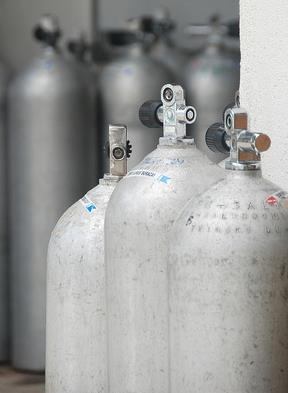
When buying a used scuba tank (aka: cylinder or bottle)...whether online from eBay or Craigslist, or from a Garage Sale or Swap Meet/Flea Market...be sure to consider the following:
Does the air tank need a hydro?Check out the markings on the scuba tank to determine if the most recent hydrostatic pressure test date is within the last 5 years. You are taking a risk in buying a tank that needs hydro. Consider the cost of a hydro inspection ($25-$40) when negotiating the purchase price. Ask the seller for a written guarantee to refund your money, and possibly the cost of the inspection, if the tank fails hydro.
Does the tank have air in it?If the tank does not currently have air in it...moisture could have gotten in, which would cause rust or corrosion. It is not recommended that you buy a used scuba tank that does not currently have air. You can ask the seller to use a pressure gauge to measure the amount of air in the tank...or slightly open the tank valve and listen for rushing air.
If aluminum, is the tank older than 1990?Before 1990, some manufactures (mainly Luxfer and Walter Kiddy...not Catalina) used a certain aluminum alloy (6351) that increases the likelihood of cracking. An Eddy-Current test ($20-$30) is required on these tanks.
If steel, does the tank have a spray-in liner or coating on the inside?On older steel tanks (usually 72 cu/ft), manufactures sometimes sprayed a coating on the inside (color varies, but usually light cream, dark red or white). This coating can conceal defects, and over time the coating itself can deteriorate. The tank can be tumbled to remove the liner, but after tumbling the tank will require maintenance more often which increases the cost.
Here are some tips on inspecting a used scuba tank:- Look for external signs of damage. If it has any dents, deep scratches or rust, then it is unlikely to pass inspection. If applicable, remove the boot on the bottom of the tank and inspect for damage.
- Check the valve for signs of damage. They are made of brass (covered with chrome) which is a soft metal, so any impact will be easily noticeable. A dropped cylinder is unlikely to pass inspection.
- Make sure the valve opens smoothly. If it is stiff, service may be required, costing around $25. If it will not open, then you won’t be able to determine if the tank has air...and the valve may need to be replaced, costing around $60.
Scrap metal value of scuba tanks:A standard aluminum 80 cu/ft tank weighs about 31 lbs empty. At current rates, scrap aluminum is worth about $0.75 per lb. So the current minimum value of an aluminum scuba tank (without the tank valve) is around $23.
A standard steel 80 cu/ft tank weighs about 35 lbs empty. At current rates, scrap steel is worth about $0.17 per lb. So the current minimum value of a steel scuba tank (without the tank valve) is around $6.
External Resources:Scuba Tank Services - Buying Used Scuba TanksDiveBuddy Forum Discussing this TopicA Consumer’s Guide to Scuba TanksHow to Buy a Used Scuba TankHow to Read Scuba Tank MarkingsHow to Select a Scuba TankAluminum vs. Steel Scuba Cylinders